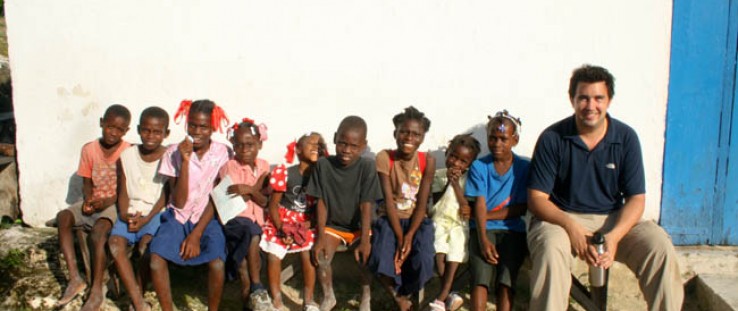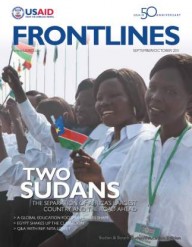 USAID's Lee Cohen with students of the Morency Primary School near Les Cayes, Haiti
Patrick Eucalitto
USAID's Lee Cohen with students of the Morency Primary School near Les Cayes, Haiti
Patrick Eucalitto
 USAID's Lee Cohen with students of the Morency Primary School near Les Cayes, Haiti
Patrick Eucalitto
USAID's Lee Cohen with students of the Morency Primary School near Les Cayes, Haiti
Patrick Eucalitto
I joined USAID in November as an education DLI (Development Leadership Initiative) officer. The DLI program was started to double the number of Foreign Service Officers in the Agency. Beyond being a simple hiring mechanism, the DLI program represents a sentiment that had been growing that the Agency needed a shot of fresh blood to accompany the new policy initiatives it had planned.
I had little exposure to USAID prior to joining—I’d worked in areas of the world where USAID worked, but as a graduate student and evaluator for a small NGO. I generally associated USAID officers as the people with the purse strings—the people who knew how things worked, where to go, who to see.
If their lifestyle might have appeared a bit glamorous to an in-debt grad student, their approach to development was surprisingly familiar. Despite working for a large bureaucracy based in Washington, D.C., their perspectives were decidedly local. It seemed almost paradoxical: a large government agency whose employees were trying new development strategies, new approaches? I decided to see it for myself.
As a new DLI officer, I went through extensive trainings. I learned about gender in development; project design; educational programming; monitoring and evaluation. There were months of trainings, some worthwhile, others frankly not as much. But no training could have prepared me for what I walked into my first real day on the job in the Office of Education.
A sweeping new education strategy was in its final stages. A brand new evaluation policy had just been finished. The Quadrennial Diplomacy and Development Review and USAID Forward had both graduated from buzz words to the central focus of this Agency.
In my second week on the job it was time to understand our new education strategy. Looking back at that first introduction, my perspective was understandably naïve: we wanted the education sector to align with USAID Forward, and the two clearest ways of doing so were through focus and accountability.
We wanted to pare down our educational interventions so that we could focus on what we knew worked, and we wanted to be able to show clear results from these interventions. With fewer interventions, it would be easier to tell our “story” at the country, regional, and Agency level.
Now, this philosophy, this approach, is not naïve. It’s actually quite sophisticated, focusing an entire sector on very specific goals and objectives. The problem was that since I had found this strategy rather clear, I had assumed it would be a relatively easy sell. I watched senior educational officers explain the strategy in town-hall style meetings, via e-mail, over countless sector meetings, and the process seemed eerily absent of dissent. At least at first.
Perhaps some people didn’t really believe that the strategy would be implemented; or, if it was implemented, it wouldn’t be enforced. Whatever the explanation, it soon became clear that the implementation of an educational strategy, one that would align every field mission with Washington’s priorities, would be more than just difficult. The process would challenge the very notion of what USAID was, of what it wanted to be, and of who decided what was best for the lives of hundreds of millions of children USAID was devoted to helping.
I have bad news. There are no answers in this article. I don’t know who should make these decisions. A host country government? A field mission that knows the situation on the ground? The Washington office, which can see the big picture? To try to advocate for one approach is an exercise in futility, because in practice all three stakeholders should be working together.
A Science of Imperfect Equations
USAID’s new Education Strategy is development. It is not a formula, with a child’s education on one side of the equation, a dollar amount on the other. It is imperfect, like every other strategy, policy, and initiative a development agency has ever thought up.
We make the best decisions we can with the information at our disposal. We take into account the priorities of a hundred different stakeholders—from taxpayers, to Congress, to children living in poverty around the world. We’re never going to find a magical balance between all these people, so what will determine the fate of this strategy is the process we use to put it into practice.
We work in a world far too complex for any one approach. It’s our colleagues and partners who help us understand the world in which we work—who help us tear down our logic and build it back up again, stronger, but never complete. This is the process.
It will take place in the sixth floor conference room next to Administrator Rajiv Shah’s office, in Education Sector Council meetings, at missions around the world, and, most of all, in classrooms—whether they be four cement walls or one shady acacia tree. We have an opportunity now to do something at USAID never done before: a global development approach to education.
Will it work everywhere, all the time? No, but when programs are falling short, we’ll know why, and how to strengthen them. Our strategy is perfected every day from Washington, our missions in the field, or sitting under that pleasant acacia tree. We work on it together, because for all our differences, we share the only characteristic that matters: an undying devotion to improving the lives of children.
The funny thing about children is that they don’t care about our processes. They don’t care about our strategy meetings, about our philosophies, about our results frameworks. They want to learn how to read, and they’re not waiting for us.
Our challenge is to harness the passion and commitment that’s been born from the process of creating a global education strategy into meaningful results for children who want to read. That’s what I’ve learned as a DLI officer since I joined; that’s what I’ll take with me this September as I head to my first post; and that’s what attracted me to USAID.
Any strategy is only as strong as the team around the world standing behind it, and as a new addition to USAID, it’s an honor to be part of this team.









Comment
Make a general inquiry or suggest an improvement.